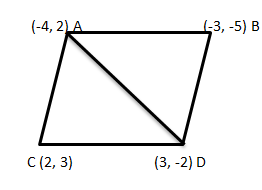
Find the area of the quadrilateral whose vertices taken in order, are \[\left( { - 4, - 2} \right),\left( { - 3, - 5} \right),\left( { - 3, - 2} \right){\text{ and }}\left( {2,3} \right)\].
Answer
606k+ views
Hint- To solve this question we will use the formula given by $\Delta = \dfrac{1}{2}\left| {{y_1}({x_2} - {x_3}) + {y_2}({x_3} - {x_1}) + {y_3}({x_1} - {x_2})} \right|$ , we will divide the quadrilateral into two triangles and then apply the formula.
Complete step-by-step solution -
Given that vertices of quadrilateral are \[\left( { - 4, - 2} \right),\left( { - 3, - 5} \right),\left( { - 3, - 2} \right){\text{ and }}\left( {2,3} \right)\]

Let \[A\left( { - 4, - 2} \right),B\left( { - 3, - 5} \right),C\left( { - 3, - 2} \right){\text{ and D}}\left( {2,3} \right)\] be the vertices of the quadrilateral.
As we know that the area of the quadrilateral ABCD= area of $\Delta ABC$ + area of $\Delta ACD$
Area of $\Delta ABC$ is given by
$ = \dfrac{1}{2}\left| {{y_1}({x_2} - {x_3}) + {y_2}({x_3} - {x_1}) + {y_3}({x_1} - {x_2})} \right|$
In $\Delta ABC$
${x_1} = - 4,{x_2} = - 3,{x_3} = 3,{y_1} = - 2,{y_2} = - 5,{y_3} = - 2$
Substituting above values in the formula, we get
$
= \dfrac{1}{2}\left| { - 2( - 3 - 3) - 5(3 + 4) - 2( - 4 + 3)} \right| \\
= \dfrac{1}{2}\left| { - 2( - 6) - 5(7) - 2( - 1)} \right| \\
= \dfrac{1}{2}\left| {12 - 35 + 2} \right| \\
= \dfrac{1}{2}\left| { - 21} \right| \\
= 10.5{\text{ sq}}{\text{.units}} \\
$
Area of $\Delta ACD$ is given by
$ = \dfrac{1}{2}\left| {{y_1}({x_2} - {x_3}) + {y_2}({x_3} - {x_1}) + {y_3}({x_1} - {x_2})} \right|$
In $\Delta ACD$
${x_1} = - 4,{x_2} = 3,{x_3} = 2,{y_1} = - 2,{y_2} = - 2,{y_3} = 3$
Substituting above values in the formula, we get
$
= \dfrac{1}{2}\left| { - 2( - 3 - 2) - 2(2 + 4) - 3( - 4 - 3)} \right| \\
= \dfrac{1}{2}\left| { - 2 - 12 - 21} \right| \\
= \dfrac{1}{2}\left| { - 35} \right| \\
= 17.5{\text{ sq}}{\text{.units}} \\
$
Therefore, the area of the quadrilateral is = $10.5 + 17.5 = 28{\text{ sq}}{\text{. units}}$
Hence, the area of the quadrilateral is $28.0{\text{ sq}}{\text{. units}}$
Note- The given problem is the coordinate geometry problem and the vertices of the quadrilateral are given. In order to solve such questions, try to break the quadrilateral in two triangles and apply the formula to calculate the area of the triangle.
Complete step-by-step solution -
Given that vertices of quadrilateral are \[\left( { - 4, - 2} \right),\left( { - 3, - 5} \right),\left( { - 3, - 2} \right){\text{ and }}\left( {2,3} \right)\]

Let \[A\left( { - 4, - 2} \right),B\left( { - 3, - 5} \right),C\left( { - 3, - 2} \right){\text{ and D}}\left( {2,3} \right)\] be the vertices of the quadrilateral.
As we know that the area of the quadrilateral ABCD= area of $\Delta ABC$ + area of $\Delta ACD$
Area of $\Delta ABC$ is given by
$ = \dfrac{1}{2}\left| {{y_1}({x_2} - {x_3}) + {y_2}({x_3} - {x_1}) + {y_3}({x_1} - {x_2})} \right|$
In $\Delta ABC$
${x_1} = - 4,{x_2} = - 3,{x_3} = 3,{y_1} = - 2,{y_2} = - 5,{y_3} = - 2$
Substituting above values in the formula, we get
$
= \dfrac{1}{2}\left| { - 2( - 3 - 3) - 5(3 + 4) - 2( - 4 + 3)} \right| \\
= \dfrac{1}{2}\left| { - 2( - 6) - 5(7) - 2( - 1)} \right| \\
= \dfrac{1}{2}\left| {12 - 35 + 2} \right| \\
= \dfrac{1}{2}\left| { - 21} \right| \\
= 10.5{\text{ sq}}{\text{.units}} \\
$
Area of $\Delta ACD$ is given by
$ = \dfrac{1}{2}\left| {{y_1}({x_2} - {x_3}) + {y_2}({x_3} - {x_1}) + {y_3}({x_1} - {x_2})} \right|$
In $\Delta ACD$
${x_1} = - 4,{x_2} = 3,{x_3} = 2,{y_1} = - 2,{y_2} = - 2,{y_3} = 3$
Substituting above values in the formula, we get
$
= \dfrac{1}{2}\left| { - 2( - 3 - 2) - 2(2 + 4) - 3( - 4 - 3)} \right| \\
= \dfrac{1}{2}\left| { - 2 - 12 - 21} \right| \\
= \dfrac{1}{2}\left| { - 35} \right| \\
= 17.5{\text{ sq}}{\text{.units}} \\
$
Therefore, the area of the quadrilateral is = $10.5 + 17.5 = 28{\text{ sq}}{\text{. units}}$
Hence, the area of the quadrilateral is $28.0{\text{ sq}}{\text{. units}}$
Note- The given problem is the coordinate geometry problem and the vertices of the quadrilateral are given. In order to solve such questions, try to break the quadrilateral in two triangles and apply the formula to calculate the area of the triangle.
Recently Updated Pages
Master Class 9 Social Science: Engaging Questions & Answers for Success

Master Class 9 Science: Engaging Questions & Answers for Success

Master Class 9 English: Engaging Questions & Answers for Success

Master Class 9 Maths: Engaging Questions & Answers for Success

Master Class 9 General Knowledge: Engaging Questions & Answers for Success

Class 9 Question and Answer - Your Ultimate Solutions Guide

Trending doubts
Which places in India experience sunrise first and class 9 social science CBSE

Fill the blanks with the suitable prepositions 1 The class 9 english CBSE

Write the 6 fundamental rights of India and explain in detail

Difference Between Plant Cell and Animal Cell

What is pollution? How many types of pollution? Define it

What is the Full Form of ISI and RAW




